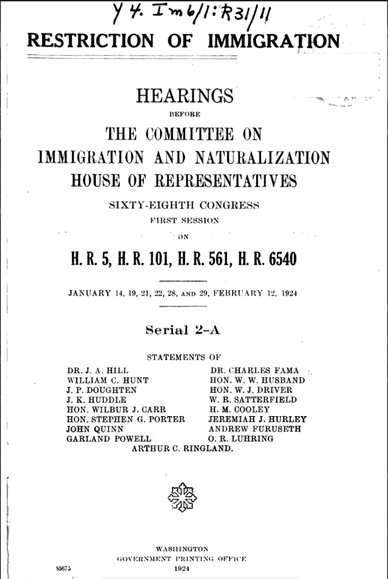The Immigration Act of 1924
Introduction
Text-to-speech Audio
The U.S. Capitol serves as a symbol of American values, both progressive and regressive. The passage of bills can either lead to advancement in American society or cause disturbances. The Immigration Act of 1924 serves as an example of regressive policies that hindered the unity within the United States. Its passage negatively impacted international ties, which would later be exacerbated during World War II.
"The Recent passage of an anti-Japanese bill by the United States Senate and Congress is a most regrettable development for those like me who have been concerned with the issue over the years" (Eiichi 81).
Much like the Chinese Exclusion Act in the latter half of the 1800s, anti-Japanese immigration legislation made an appearance in the early to mid-1900s. However, explicit legislation against the Japanese did not make it past West Coast laws prior to World War I. While World War I slowed the passage of explicit anti-Japanese legislation, sentiments towards Japanese immigration gradually soured. With the Asiatic Exclusion League still in action, and other factors contributing to the Japanese exclusion movement, a solid foundation existed for legislation to appear that specifically excluded Japanese immigrants, as well as limiting immigration from other countries.
The Immigration Act of 1924 exacerbated tension between Japan and the United States, leading to public outcry from the Japanese. Additionally, Shibusawa Eiichi mentioned in his 1924 account that, "according to the newspapers, American public opinion is severely critical of the exclusion law" (Eiichi 86). Despite disapproval in both the United States and Japan, the Act would remain in place for years. U.S.-Japanese relations experienced a steep decline after the passage of the Act, and as historian Izumi Hirobe explains, the Act
"is recognized as one of the principal causes of the deadly clash between the United States and Japan that began in 1941" (Hirobe 1).
While immigration restrictions were lifted for certain Asian nations during World War II, restrictions on Japanese immigration and anti-Japanese racism continued throughout the war.
Images
Cover Page of the Hearings before the Committee on Immigration and Naturalization, 1924

Backstory and Context
Text-to-speech Audio
"Until now we have been protected, however imperfectly, by the Gentlemen’s Agreement concluded in President Roosevelt’s time, but the United States Congress regarded this not as a treaty but simply as a private arrangement that they were not obliged to honor" (Eiichi 85).
The Gentlemen's Agreement of 1907 protected students and businessmen, as well as diplomats. However, the Agreement was not ratified by Congress and essentially acted exactly as its name suggests: an agreement. While it placated less vocal exclusionists, it did not eradicate anti-Japanese sentiments.
After World War I ended, the Japanese suggested a racial-equality clause for the League of Nations Covenant, but received rejection from the other attending powers (Hirobe 5). Japan's suggestion, however, unnerved Japanese exclusionists. As Lon Kurashige explains, exclusionists argued that Japan's suggestion of a racial-equality clause "was an entering wedge for the elimination of exclusionary immigration policies in the United States and around the world" (Kurashige 113). A new urgency entered the exclusion movement, re-introducing calls for strict Japanese exclusion.
The Immigration Act of 1924 took exclusionary policies one step further: the introduction of a national origins quota. As Peter Duus and Kenji Hasegawa explain:
"...aimed at maintaining the ‘purity’ of American society...In 1924 the U.S. Congress passed a new immigration law that placed national quotas on all immigrants from European countries and brought an end to all immigration from Japan and the rest of Asia" (Duus and Hasegawa 50).
The quota system of the 1924 Immigration Act stated that "the annual quota of any nationality shall be 2 per centum of the number of foreign-born individuals of such nationality resident in continental United States as determined by the United States census of 1890" (Immigration Act of 1924, 5). In addition to such quotas, any immigrants considered "aliens ineligible for citizenship" would not be permitted into the United States unless they qualified for immigration in another way, which would have called for an exceptional circumstance (Immigration Act of 1924, 7). As upheld by the Supreme Court only two years prior, Japanese immigrants were considered "ineligible for citizenship," thus the Act restricted Japanese immigration to the United States.
Sources
Chin, Doug. “The Chinese Exclusion Acts: A Racist Chapter in U.S. Civil Rights History.” Chinese American Forum 33, no. 1 (July 2017): 19-21.
Daniels, Roger. Asian America: Chinese and Japanese in the United States Since 1850. [N.p.]: University of Washington Press, 2011.
Duus, Peter, and Kenji Hasegawa. Rediscovering America: Japanese Perspectives on the American Century. Twentieth-Century Japan: The Emergence of a World Power. Berkeley: University of California Press, 2011.
Eiichi, Shibusawa. “On the Anti-Japanese Movement in America.” 1924. Featured in Rediscovering America: Japanese Perspectives on the American Century. Twentieth Century Japan: The Emergence of a World Power, edited by Peter Duus and Kenji Hasegawa, 80-86. Berkeley: University of California Press, 2011.
Hirobe, Izumi. Japanese Pride, American Prejudice: Modifying the Exclusion Clause of the 1924 Immigration Act, Asian America. Stanford University Press, 2001.
Immigration Act of 1924, 68th Congress, Session 1. Approved May 24, 1924. San Diego State University, https://loveman.sdsu.edu/docs/1924ImmigrationAct.pdf.
Kurashige, Lon. Two Faces of Exclusion: The Untold History of Anti-Asian Racism in the United States. Chapel Hill: The University of North Carolina Press, 2016.
Marinari, Maddalena, Madeline Hsu, and Maria Cristina Garcia. A Nation of Immigrants Reconsidered: US Society in an Age of Restriction, 1924-1965. Studies of World Migrations. Urbana: University of Illinois Press, 2019.
“The Immigration Act of 1924 (The Johnson-Reed Act).” Office of the Historian. Department of State - United States of America. Accessed April 10, 2023. https://history.state.gov/milestones/1921-1936/immigration-act.
"Restriction of Immigration," Government Printing Office, Washington, D.C., 1924. Digitized by Google Books. https://www.google.com/books/edition/Restriction_of_Immigration/8YX4tc5sp2UC?hl=en&gbpv=0
